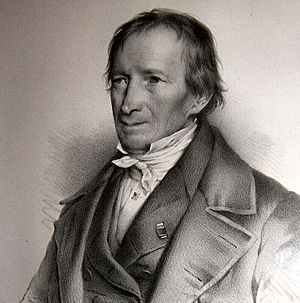Johann Nepomuk von Fuchs facts for kids
Johann Nepomuk von Fuchs (born May 15, 1774 – died March 5, 1856) was a clever German scientist. He was a chemist, who studies what things are made of, and a mineralogist, who studies rocks and minerals. He also worked as a special advisor to the king of Bavaria.
A Scientist's Life
Johann Nepomuk von Fuchs was born in a place called Mattenzell, near Falkenstein, in the Bavarian Forest. This was in Germany.
In 1807, he became a professor at the Ludwig Maximilian University. He taught about chemistry and minerals. At that time, the university was in a city called Landshut.
Later, in 1823, he became the person in charge of the mineral collections in Munich. Three years after that, when the university moved to Munich, he became a professor there too.
He stopped working in 1852. In 1854, the king of Bavaria gave him a special honor, making him a nobleman. Johann Nepomuk von Fuchs passed away in Munich on March 5, 1856.
Amazing Discoveries
Johann Nepomuk von Fuchs is famous for his work with minerals. He also did a lot of important research on a substance called waterglass. Waterglass is also known as sodium silicate.
He used waterglass to create a special way of painting called stereochromy. This was a type of fresco painting, which means painting on wet plaster. In stereochromy, the colors are made permanent using waterglass. People sometimes even called waterglass "Fuchs's soluble glass" because of his work!
He also found a scientific way to make cement. Cement is a very important material used in building. Plus, he helped us understand more about how solid things can be amorphous. This means they don't have a clear, organized shape like a crystal.
Johann Nepomuk von Fuchs also gave names to some minerals. He named wagnerite in 1821 and margarite in 1823. He also helped describe another mineral called mesolite in 1816. There's even a type of muscovite mineral named after him, called fuchsite!
His Books
Johann Nepomuk von Fuchs wrote several books about his scientific work:
- Ueber die Entstehung der Porzellan-Erde, 1821 – This book was about how porcelain clay is formed.
- Neue Methode das Bier auf seine wesentlichen Bestandtheile zu untersuchen, 1836.
- Naturgeschichte des Mineralreichs, 1842 – This book was about the natural history of the mineral world.
- Über die Theorien der Erde, den Amorphismus fester Körper und den gegenseitigen Einfluß der Chemie und Mineralogie, 1844 – This book discussed ideas about Earth, the amorphous state of solids, and how chemistry and mineralogy influence each other.
- La stéréochromie: peinture monumentale, 1861 – This was a French translation of his work on stereochromy, the special painting method.
See also
 In Spanish: Johann Nepomuk von Fuchs para niños
In Spanish: Johann Nepomuk von Fuchs para niños


